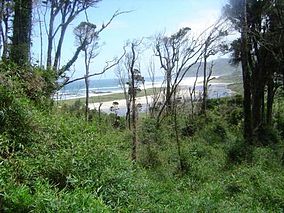- Chiloé National Park
-
Chiloé National Park IUCN Category II (National Park)
Abtao, Chiloé National ParkLocation Los Lagos Region, Chile Nearest city Chonchi Area 431 km² Established 1983 Governing body Corporación Nacional Forestal Chiloé National Park is a national park of Chile, located in the western coast of Chiloé Island, in Los Lagos Region (region of the lakes). It encompasses an area of 430.57 km2 (166 sq mi) divided into two main sectors: the smallest, called Chepu, is in the commune of Ancud, whereas the rest, called Anay, is in the communes of Dalcahue, Castro and Chonchi. The greater portion of the Park is in the foothills of Chilean Coastal Range, known as the Cordillera del Piuchén. It includes zones of dunes, Valdivian temperate rain forests, swamps, and peat bogs. A small portion, Metalqui, is an islet with an area of 0.5 km2 (0.19 sq mi). It is located between 42° 07' and 42° 13' south latitude and between 73° 55' and 74° 09' west longitude (see 42°06′S 74°01′W / 42.10°S 74.02°W).
Contents
History
The park was created by Supreme Chilean Decree N° 734, in 1983. Its surface area has been reduced by more than 45 km2 (17 sq mi) by populated land that was initially in the protected area.
Climate
The climate is wet and temperate, with average annual temperatures of 11 °C (52 °F) and abundant precipitation distributed uniformly throughout the year, varying according to the altitude. On the Pacific coast over 3,000 mm (120 in) fall annually, while in the higher elevations of the Piuchén, nearly 5,000 mm (200 in) fall, and on the rainshadowed eastern slopes, as little as 2,500 mm (98 in) in annual precipitation is measured.
Flora
The predominant vegetation is that of the Valdivian forest, a dense forest formed by perennial trees, shrubs and climbing plants. The rainforests are made up of evergreen southern beech (Nothofagus), and some native conifers, including the magnificent alerce (Fitzroya cupressoides). Extensive bogs and swamps are found in the hills. The Chilean rhubarb is also very common.
Notes
References
Translated from the Spanish site (see interwiki link).
National Parks of Chile Alberto de Agostini | Alerce Andino | Archipiélago de Juan Fernández | Bernardo O'Higgins | Bosque de Fray Jorge | Cabo de Hornos | Chiloé | Conguillío | Corcovado | Hornopirén | Huerquehue | Isla Guamblin | Isla Magdalena | La Campana | Laguna del Laja | Laguna San Rafael | Las Palmas de Cocalán | Lauca | Llanos de Challes | Llullaillaco | Nahuelbuta | Nevado Tres Cruces | Pali Aike | Pan de Azúcar | Puyehue | Queulat | Radal Siete Tazas | Rapa Nui | Tolhuaca | Torres del Paine | Vicente Pérez Rosales | Villarrica | Volcán Isluga

This article related to a protected area in South America is a stub. You can help Wikipedia by expanding it.

